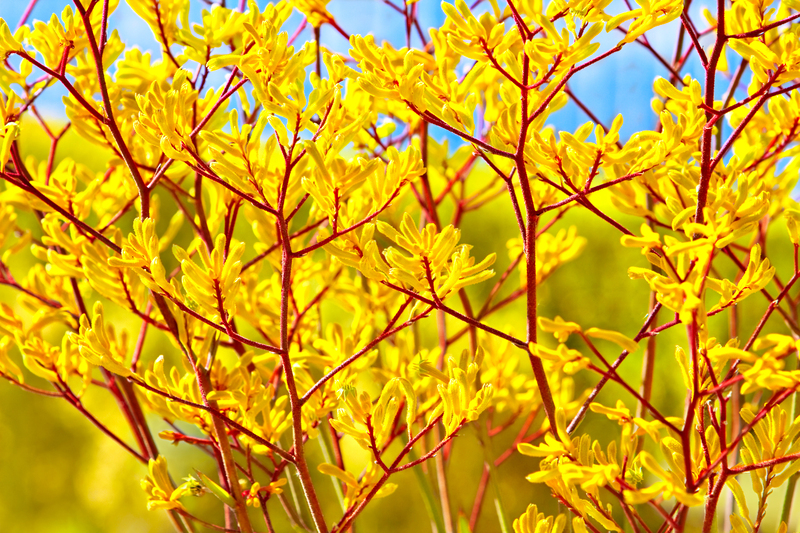Repainting Organic Refuse into Sustainable Soil Solutions
Posted on 17/06/2025
Repainting Organic Refuse into Sustainable Soil Solutions: A Comprehensive Guide
In the pursuit of more sustainable and eco-friendly practices, the management of organic refuse has garnered significant attention. But what does it truly mean to transform waste into wealth, specifically through the process of repainting organic refuse into sustainable soil solutions? This article delves into the transformative journey of organic waste, exploring methods, benefits, and the future of creating nutrient-rich soil from what once was just discarded material.

The Importance of Organic Refuse Management
As the global population rises, so does the amount of waste produced. A significant portion of this is organic refuse--food scraps, yard trimmings, and agricultural byproducts. Traditional disposal methods, such as landfilling or incineration, contribute to greenhouse gas emissions and environmental degradation. However, by converting organic refuse into sustainable soil solutions, we can address both waste management and soil health.
- Reduces landfill waste volume
- Minimizes greenhouse gas emissions
- Improves soil fertility and structure
- Supports local agriculture and food production
- Promotes a circular, regenerative economy
What Is Organic Refuse?
Organic refuse includes any biodegradable waste derived from living organisms. This encompasses:
- Kitchen scraps (vegetables, fruits, eggshells, coffee grounds)
- Yard clippings (grass, leaves, branches)
- Paper and cardboard (uncoated and non-printed)
- Agricultural byproducts (crop residues, manure)
All these materials hold immense potential for soil regeneration when repurposed consciously.
The Concept of "Repainting" Organic Refuse
In the context of sustainability, repainting organic refuse refers not to literal coloring but to its creative transformation. It's about changing the perceived value of waste by re-visualizing it as a resource capable of nourishing ecosystems and communities. This paradigm shift is key for a future where sustainability and waste management go hand-in-hand.
From Trash to Treasure: How Does the Repainting Process Work?
At the heart of this movement is the science of breaking down organic refuse through natural processes. The primary methodologies include:
- Composting: Biological decomposition of organic materials, generating rich humus for soils.
- Vermicomposting: Utilization of worms (often red wigglers) to transform organic matter into nutrient-dense castings.
- Biodigestion: Anaerobic digestion producing both biogas (renewable energy) and bio-slurry (liquid compost).
- Bokashi Fermentation: Lactic acid fermentation to rapidly pre-digest food waste, suitable for urban environments.
Each process repaints organic refuse in its own way, turning waste streams into streams of abundance.
Harnessing the Power of Composting
Why Compost?
Composting remains the most widely embraced method of transforming organic refuse into a sustainable soil solution. Here's why:
- Improves Soil Health: Compost enhances soil fertility, water retention, and microbial life.
- Reduces Synthetic Inputs: Healthy, compost-amended soils require fewer chemical fertilizers and pesticides.
- Mitigates Climate Change: Composting prevents methane formation in landfills and sequesters carbon in soil.
- Supports Urban Greening: Cities utilize compost for landscaping, gardens, and green roofs.
Composting Techniques for Every Setting
There are several ways to execute composting based on available space and resources:
- Backyard Composting: Ideal for households and small gardens; involves layered bins or piles using food and yard waste.
- Community Composting: A collective effort in neighborhoods or towns, handling larger volumes and often managed by local groups.
- Industrial Composting: Large-scale facilities process municipal organic waste, using high temperatures to speed breakdown and kill pathogens.
Proper composting requires the right balance of carbon-rich "browns" (leaves, paper, straw) and nitrogen-rich "greens" (kitchen scraps, grass clippings). The interplay of these materials underpins efficient decomposition, ensuring high-quality compost that can feed gardens, farms, and even urban green spaces.
Innovative Approaches: Bokashi and Vermicomposting
Bokashi: The Fast-Track Fermentation Method
Bokashi is a revolutionary technique of repainting food waste into pre-compost. Utilizing a mix of effective microbes in an airtight container, Bokashi can even process meat and dairy, which traditional composting often excludes. Its benefits include:
- Speed: Fermentation takes just 2-4 weeks.
- Odor Control: Anaerobic, so minimal smell.
- Versatility: Handles a wider range of organics.
- Enriched Soil: Produces a potent soil amendment when buried or added to compost heaps.
Vermicomposting: Earthworm Alchemy
Vermicomposting employs special worms to "repaint" organic refuse into highly nutritious castings (worm poop). This system is perfect for homes, classrooms, and institutions, owing to its:
- Space Efficiency: Small bins fit under sinks or in closets.
- High-Quality Output: Worm castings are richer in nutrients than regular compost.
- Educational Value: Encourages awareness and engagement with natural cycles.
Biodigestion: Repainting Waste into Energy and Soil Enhancer
Anaerobic digestion takes the concept of repainting organic refuse a step further--not only producing a soil amendment but also renewable energy. Here's how it works:
- Organic waste is sealed in a biodigester tank, which excludes oxygen.
- Microbial communities break down the waste, emitting methane-rich biogas.
- The byproduct, known as bio-slurry, is a nutrient-packed liquid fertilizer.
Biodigesters are increasingly used on farms, in food processing facilities, and even as decentralized solutions in urban settings, helping reduce fossil fuel dependence while enhancing soil fertility.
The Science Behind Turning Organics into Soil Solutions
Microbial Magic: The Key to Transformation
The quadruple alliance of fungi, bacteria, actinomycetes, and protozoa orchestrates the breakdown and transformation of complex organic molecules into simpler, plant-available nutrients. These microorganisms
- Decompose cellulose, lignin, and proteins
- Release nitrogen, phosphorus, potassium, and micronutrients
- Build humus, improving soil structure and water holding
- Protect plants by outcompeting pathogens and pests
The science is clear: repainting organic refuse is fundamentally an act of nurturing life, both unseen and visible.
Building Regenerative Ecosystems
Healthy soil is the bedrock of strong, resilient ecosystems. By continuously repainting organic refuse into sustainable soil solutions, we close nutrient loops, foster biodiversity, and enable more productive gardens and farmlands. This regenerative approach yields not just food, but environmental, social, and economic benefits.
Environmental and Social Benefits
- Enhanced Food Security: Richer soils mean higher crop yields and greater resilience to climate shocks.
- Job Creation: Composting and circular waste industries generate employment at local levels.
- Pollution Reduction: Fewer landfills and less waste incineration curb air and water pollution.
- Urban Revitalization: Community gardens flourish with composted soils, transforming derelict spaces.
- Education and Empowerment: Composting teaches ecological literacy and stewardship.
Implementing Sustainable Soil Solutions at Home
Step-by-Step Guide: Home Composting
- Select a Compost Bin: Choose between open piles, tumbler bins, or worm farms according to available space.
- Add Materials: Alternate between "greens" (kitchen waste, grass clippings) and "browns" (leaves, paper).
- Moisten and Mix: Materials should be damp but not soggy; turn the pile every week for aeration.
- Monitor: Compost is ready when it is earthy, dark, and crumbly, usually after 2-6 months.
By following these simple steps, you enable your household to repaint organic refuse into a potent sustainable soil solution.
Scaling Up: Community and Municipal Soil Solutions
For maximal impact, larger-scale initiatives are essential. Local governments and community organizations can catalyze action through
- Centralized composting programs with curbside collection
- Dedicated drop-off points for organic refuse at farmers' markets and waste centers
- Educational campaigns teaching residents how to segregate and compost waste
- Partnerships with farmers and landscapers for reusing the finished compost
When entire communities unite in repainting organic refuse into life-giving soil amendments, the scale of environmental repair is truly transformative.
Addressing Challenges in Organic Refuse Repainting
Common Obstacles
- Contamination: Non-organic materials (plastics, metals) in the feedstock
- Odors and Pests: Improper management attracting vermin
- Lack of Awareness: Limited public knowledge of composting techniques
- Space Constraints: Especially in densely populated urban areas
Overcoming Barriers
- Effective Sorting: Proper education and user-friendly signage at drop-off locations
- Enclosed Systems: Using sealed bins and commercial digesters to manage smells and pests
- Advocacy and Policy: Supporting regulations that mandate organic waste diversion
- Innovation: Portable composters and small-scale biodigesters for tight spaces
Attentively addressing these challenges ensures the continued success of repainting refuse into sustainable soil solutions.

The Future of Repainting Food Waste and Organic Materials
Technologies and social practices in sustainable soil solutions are rapidly evolving. Exciting developments include:
- AI-powered waste sorting systems to automate the removal of contaminants
- Community-supported agriculture (CSA) partnerships driving compost use in local farms
- Soil microbiome analysis unlocking tailored compost blends for specific crops and climates
- Urban vertical farming using composted soils for eco-friendly food production
Ongoing research and innovation promise to expand the scope and efficiency of repainting organic refuse for environmental and societal benefit.
Conclusion: Every Meal a New Beginning
To repaint organic refuse into sustainable soil solutions is to embrace a radical reimagination of waste--not as an endpoint, but as the genesis of renewed ecological value. At the heart of sustainability lies the principle of regeneration, and each effort--from a single compost bin to municipal-scale organic waste programs--paints the world greener for generations to come.
By taking responsibility for organic waste at every level, we can restore soils, rejuvenate communities, and seed a healthier planet.
Let's all be artists in the living masterpiece of environmental stewardship--one banana peel, leaf, or coffee ground at a time.

